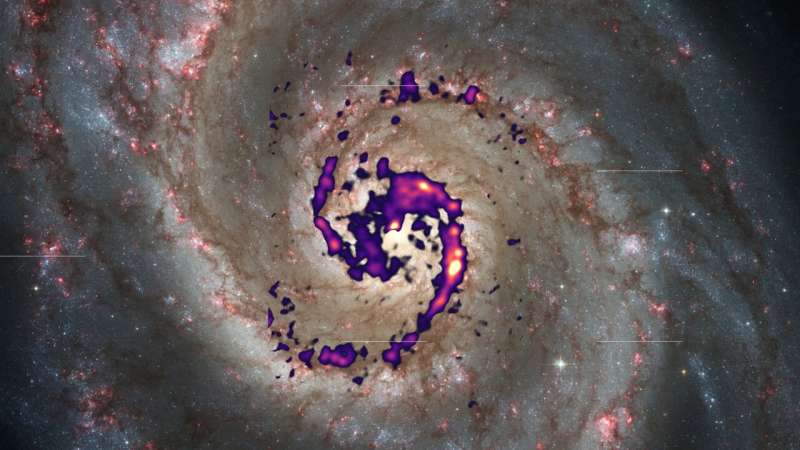This article has been reviewed according to Science X's editorial process and policies. Editors have highlighted the following attributes while ensuring the content's credibility:
fact-checked
peer-reviewed publication
trusted source
proofread
Research charts stellar birthplaces in the Whirlpool galaxy for the first time

An international research team led by the Max Planck Institute for Astronomy (MPIA) and involving the University of Bonn has mapped the cold, dense gas of future star nurseries in one of our neighboring galaxies with an unprecedented degree of detail. The data will enable the researchers for the first time to mount an in-depth study of the conditions that exist within the gas during the early stages of star formation outside the Milky Way at the scale of individual star-forming regions.
Their findings have now been published in Astronomy & Astrophysics.
Paradoxically, hot stars begin to form in some of the coldest regions of the universe, specifically in thick clouds of gas and dust that straddle entire galaxies. "To investigate the early phases of star formation, where gas gradually condenses to eventually produce stars, we must first identify these regions," says Sophia Stuber, a doctoral student at the MPIA in Heidelberg and the first author of the research paper.
"For this purpose, we typically measure the radiation emitted by specific molecules that are particularly abundant in these extremely cold and dense zones." Astronomers generally use molecules such as HCN (hydrogen cyanide; also known as prussic acid) and N2H+ (diazenylium) as chemical probes for this purpose.
Using molecules as chemical probes
Thanks to the large-scale observation program known as SWAN (Surveying the Whirlpool at Arcseconds with NOEMA), the researchers have now been able to undertake these measurements across a vast area across another galaxy, having previously been restricted to our own Milky Way.
The SWAN team used the Northern Extended Millimeter Array (NOEMA), a radio interferometer in the French Alps, to study the distribution of radiation from several molecules within the central 20,000 light years of the Whirlpool galaxy (Messier 51). The 214 hours of observations from this program are being supplemented by about 70 more from another survey using a 30-meter single dish telescope in southern Spain.
One of the leaders of the SWAN project is Professor Frank Bigiel from the Argelander Institute for Astronomy at the University of Bonn, who states, "The spectral lines of the different molecules let us draw highly specific conclusions about the physical properties of the gas, such as its density. This allows us to make a detailed study of what conditions in the interstellar medium are conducive to star formation within galaxies. For the first time, we're now in a position to investigate large areas of a galaxy in this way—and do so at a higher resolution than ever before, so that we can even distinguish between individual star-forming regions."
Gas properties are environment-dependent
In the study that has now been published, the researchers focused on two molecules: Hydrogen cyanide and diazenylium. Because the Whirlpool galaxy is a mere 28 million light years away, it is even possible to study characteristics of individual gas clouds in regions as different as its center or its spiral arms. "We leveraged this circumstance to determine how well the two gases trace the dense clouds in this galaxy for us and whether they are equally suited," Stuber explains.
While the intensity of the radiation given off by hydrogen cyanide and diazenylium rises and falls to the same extent along the spiral arms, thus delivering equally good results for determining gas density, the astronomers have found a marked difference in the galaxy's central region, where the brightness emitted by hydrogen cyanide increases much more significantly. In other words, there appears to exist a mechanism that causes the hydrogen cyanide to shine more brightly but not the diazenylium.
The team suspects that responsibility for this phenomenon could lie with the Whirlpool galaxy's active galactic nucleus, a high-energy zone surrounding the massive black hole in its center. Before the gas falls into the black hole, it is pushed into a disk shape, accelerated to high speeds and heated up to thousands of degrees Celsius by friction.
This causes it to emit intense radiation, which could indeed explain some of the extra emission from the hydrogen cyanide molecules. "However, we still need to explore in detail what makes the two gases behave differently," adds Eva Schinnerer, research group head at the MPIA and another co-leader of the SWAN project.
A worthwhile challenge
It would therefore appear that diazenylium is a more reliable "density probe" than hydrogen cyanide, at least within the Whirlpool galaxy's central zone. Unfortunately, however, it shines an average of five times more dimly at the same level of gas density, considerably increasing the time and effort required for measurements. The additional sensitivity that is needed thus comes at the price of much more observation time.
"These investigations have brought us another step closer to answering our fundamental question of how stars are formed," says Professor Bigiel, a member of the Transdisciplinary Research Area "Matter" at the University of Bonn. "We'll now be able to pool our data with observations of star formation activity and come up with an overall picture."
Over the long term, this would enable answers to questions such as "How dense does the gas need to be for stars to form?" and "What are the best 'probes,' or molecules, for tracking down this gas inside galaxies?"
More information: Sophia K. Stuber et al, Surveying the Whirlpool at Arcseconds with NOEMA (SWAN), Astronomy & Astrophysics (2023). DOI: 10.1051/0004-6361/202348205
Journal information: Astronomy & Astrophysics
Provided by University of Bonn





















